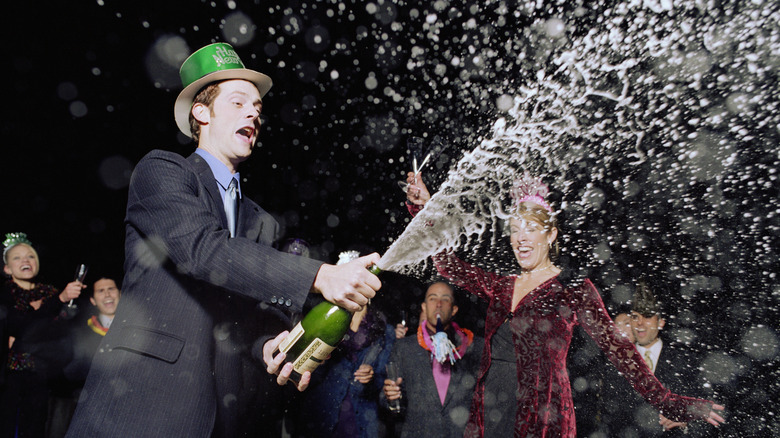Your Champagne Bottle Shouldn't Really Pop
You know when you're watching a movie and the protagonist gets a job promotion or wins the big game, and bottles of Champagne are being opened like firearms discharging? Yeah, don't do that in real life. Spare your bottle of champers the agony and disrespect of blasting its cork out like a Nerf gun dart (not to mention potentially blinding your dining companions). Doing this doesn't just make you look unsophisticated; it ruins a perfectly good sparkling wine. Instead, try releasing the cork with a gentle twist — it should come out with a whisper rather than a scream.
Opening a Champagne bottle correctly is a little more complicated than a simple twist, but more on that later. First, be sure you're serving the wine at the correct temperature. If the bottle is too warm, the cork can more easily pop out in an exciting (albeit wasteful and probably startling) spray across the dining table. The proper temperature for Champagne, according to G.H. Mumm, is 46 to 50 degrees Fahrenheit; this is easily maintained outside of the fridge if you don't plan on opening the bottle right away by keeping it on ice.
Treat your Champagne right
Another mistake to avoid when handling Champagne is the storage of the wine. Many people are prone to keeping their wines in the refrigerator door. This is a terrible idea for Champagne because of all the jostling the bottle endures when the door opens and closes. (This can also lead to accidental cork evacuation, which no one wants). It feels like it goes without saying, but don't shake the bubbly! You can ruin the effervescence of the wine if you bounce the bottle around too much, so be mindful of how you're storing and transporting your Champagne.
Storing Champagne on its side can be beneficial to the longevity of the wine by helping preserve the bubbles. While Champagne doesn't benefit from saving on the shelf for many years like a full-bodied red, it will keep for months in a cool, dry place when stored horizontally. Inversely, never, ever put your Champagne in the freezer. At best, it will destroy the bubbles and the wine's structure, and at worst, you'll end up with a little freezing volcano.
The little sigh of uncorking Champagne
So how do you properly open a bottle of Champagne? First, you'll need a couple of things: a tea towel and a wine tool. Begin by cutting the foil off the Champagne with the wine tool. Wrap your tea towel or cloth napkin around the cage of the cork and untwist the cage — always give the cage six twists counter-clockwise. Make sure you're applying decent downward pressure to the cage as you untwist it because you don't know what your Champagne has gone through and what kind of pressure is in the bottle.
Next, grab the cork and gently twist the bottle. No one wants bits of broken cork in their wine, so by twisting the bottle with a firm grip, you'll take torque off the cork and prevent breakage. This is when you should hear what the French call "le soupir erotique," or the sexy little sigh your bottle lets out when it depressurizes. Don't whip the cork straight out. Instead, ease it out as the rest of the pressure dissipates. Give the Champagne a moment; you've both been through a lot. Finally, wipe the lip of the bottle and serve. It takes a little practice to open a bottle of sparkling wine correctly, but once you get the hang of it, you can revel in the beauty of understatement. And if you still feel the need to blow up a bottle, make sure it's the cheap stuff.


